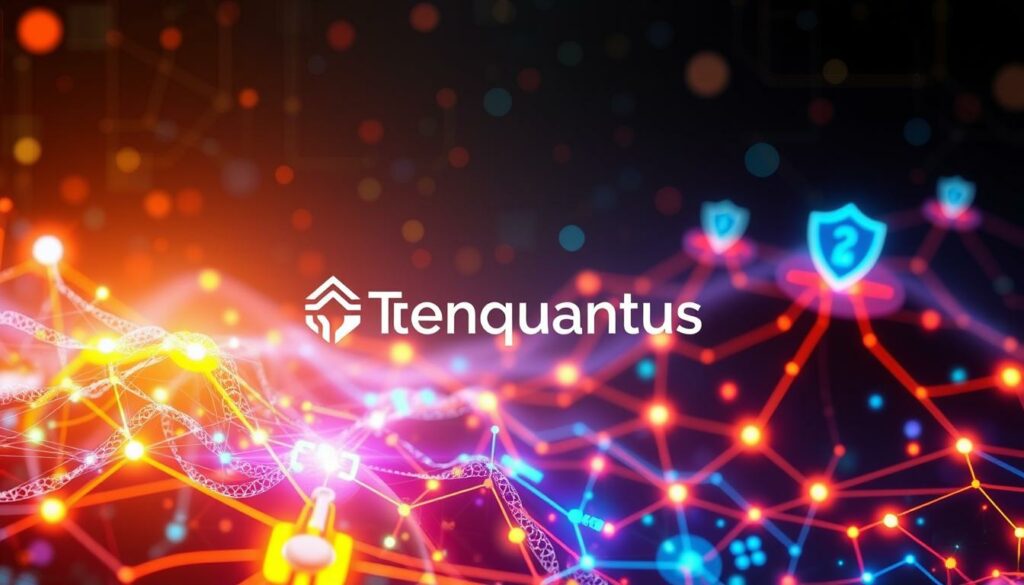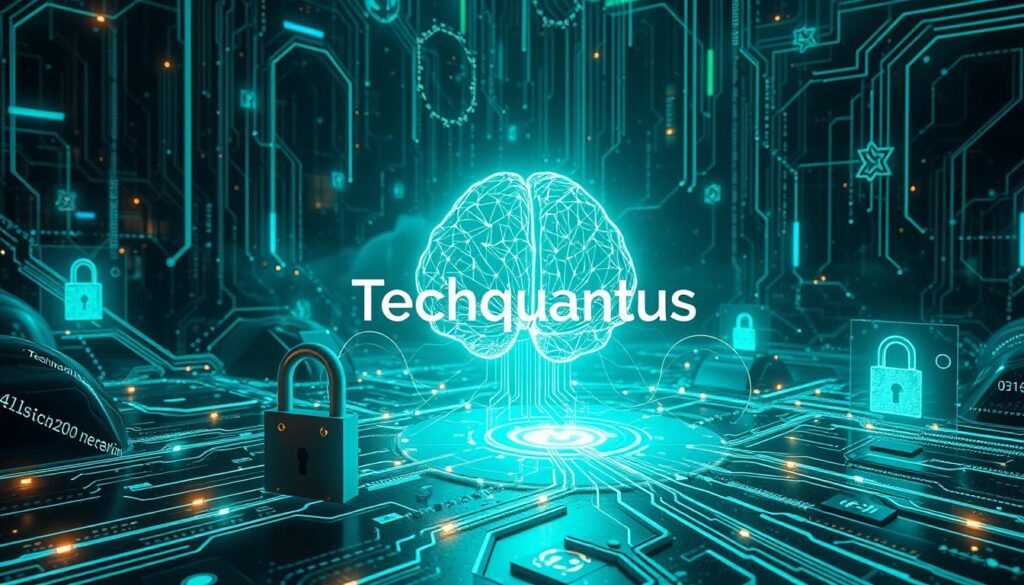Did you know the global blockchain market could hit $69 billion by 2027? As things get more decentralized, we need better security fast. Using AI and Blockchain together is a game-changer for keeping data safe and making processes smoother across different areas. This piece will show you how to use AI and Blockchain to make your security stronger, ready for today’s digital world.
Learning about AI and Blockchain and their role in secure systems helps us see how they can fix weaknesses. The mix of AI’s smart predictions and Blockchain’s solid, unchangeable nature offers a big chance for a new way of handling security. This guide will lead to a deeper look at how to combine AI and Blockchain, their advantages, real uses, and what’s coming next.
For more on how these technologies meet in cybersecurity, check out TechQuantus.
Key Takeaways
- The combination of AI and Blockchain technologies enhances security protocols.
- Decentralized systems benefit from AI-driven anomaly detection and predictive analytics.
- Blockchain ensures data integrity, transparency, and immutability.
- AI can help identify vulnerabilities within smart contracts.
- Real-world applications in finance and supply chain demonstrate the effectiveness of this integration.
Understanding AI and Blockchain
Artificial intelligence and blockchain are changing the world. They improve many areas like data analysis, cybersecurity, and decentralized systems. It’s key to know about them before looking at how they work together.
What is AI?
AI makes machines think and learn like humans. These machines use data to improve over time. AI helps in many areas, from customer service to complex data analysis.
It makes things more efficient by spotting patterns and predicting outcomes. This helps many industries work better.
What is Blockchain?
Blockchain is a secure way to keep track of transactions on many computers. It makes sure records can’t be changed, making everything clear for everyone. This tech solves many old problems, like trust and data security issues.
By using decentralized systems, blockchain cuts out middlemen. This makes transactions faster and cheaper.
| Technology | Definition | Applications |
|---|---|---|
| AI Technology | Simulation of human intelligence in machines | Data analysis, natural language processing, automated tasks |
| Blockchain Technology | Decentralized ledger for secure transaction recording | Cryptocurrency, supply chain management, identity verification |
The Importance of Enhanced Security in Decentralized Systems
In today’s digital world, keeping information safe is crucial. Traditional systems often leave organizations open to big risks. They focus on one point, making them easy targets for hackers. This can cause data breaches, leading to big financial losses and harming reputations.
With 98% of businesses struggling to share accurate info on time, the stakes are high. If important data gets into the wrong hands, the risks grow even more.
Vulnerabilities in Traditional Systems
Centralized systems face many risks, including:
- Single Point of Failure: If the central server fails or gets hacked, all data access could be lost.
- Increased Risk of Data Breaches: Hackers might target one spot to get to a lot of data.
- Inconsistent Data Handling: Different departments use different systems, leading to mistakes that could cause lost sales.
To fight these issues, companies are moving to decentralized systems. This change helps keep data safe and secure.
Advantages of Decentralization
Decentralized systems bring big security benefits:
- Resilience: Data stays safe even if one part of the system fails.
- Data Integrity: With data spread out, it’s harder to change without permission.
- Community Trust: These systems build trust by being open and accountable.
Using decentralized systems makes things more secure and efficient. It lowers the risks of centralized databases. Adding smart contract audits is key to protect against threats and build trust in digital deals.
How AI Enhances Data Security in Blockchain
The blend of AI and blockchain technology is changing how we protect data. AI helps find and stop weak spots in blockchain systems. This makes it easier for companies to fight threats and keep data safe.
AI-Driven Anomaly Detection
AI is key in spotting odd transactions that might be fake. It uses smart algorithms to catch unusual patterns right away. This quick action helps stop fraud before it’s too late.
Every year, businesses lose billions to scams. But with Blockchain AI, finding these odd transactions is easier. This is crucial in a world filled with threats.
Predictive Analytics for Threat Prevention
Predictive analytics helps blockchains predict security issues before they happen. By looking at past data, companies can fix weak spots. This makes users trust blockchain more.
Companies like BBVA are now using advanced predictive tools. They offer services for USD Coin, Bitcoin, and Ether. For more info, check their updates here.
| Technology | Functionality | Benefits |
|---|---|---|
| AI-Driven Anomaly Detection | Identifies unusual transaction patterns | Minimizes risks of fraud related losses |
| Predictive Analytics | Anticipates potential security breaches | Increases trust and confidence in blockchain |
| Blockchain Technology | Secures transaction processes and records | Enhances overall data integrity |
Blockchain’s Role in Securing AI Data Management
As businesses use artificial intelligence more, keeping data safe and true is key. Blockchain is a powerful tool for this, offering a secure way to manage data. It builds trust with its unique features. By using decentralized and clear systems, companies can make sure AI data is both trustworthy and safe from changes.
Data Integrity and Transparency
Blockchain is great at keeping AI data integrity safe. In old systems, data can get corrupted or changed without permission. Blockchain stops one person from changing the data, making sure everyone sees the same info. It’s also clear and open, so all actions are easy to check and hold people accountable.
Immutable Records for AI Training
For AI training, having good and steady data is key. Blockchain makes sure records can’t be changed or erased once they’re in. This is super important in areas like healthcare and finance, where the data must be right. Using blockchain, companies can be sure their training data stays correct, reducing risks from data changes.
| Feature | Blockchain | Traditional Systems |
|---|---|---|
| Data Integrity | High, with complete immutability | Vulnerable to tampering |
| Transparency | Full visibility for all stakeholders | Limited, often requiring audits |
| Security | Decentralized and encrypted | Centralized and often prone to breaches |
| Accountability | Traceable and auditable | Difficult to enforce |
The Benefits of Combining AI and Blockchain Technologies
AI and Blockchain together bring big advantages to many industries. They help make things run smoother and build trust. This is key in today’s fast-paced world. The benefits of AI and Blockchain are clear, especially in handling data and making transactions faster.
Increased Efficiency
AI helps look at data on Blockchain quickly and efficiently. This combo makes things faster and smoother. Here’s how:
- Automated check pipelines to keep data accurate and up-to-date.
- Machine learning makes data work better, saving money.
- Models get updated regularly to stay sharp and relevant.
- End-to-end apps find important insights fast, saving time.
Enhanced Trust and Security
AI and Blockchain together create a safe space that builds trust. This combo makes data safe and reliable. Here’s how:
- Immutable records for AI training keep things clear and honest.
- Strict checks make sure smart contracts are correct.
- Strong security like encryption and access control fights off threats.
Working with a trusted smart contract audit company adds extra safety. For more on using AI for better data management and analytics, check out this resource.
Identifying Use Cases for AI and Blockchain
AI and Blockchain are changing many industries with new solutions. The financial technology sector has seen big improvements. These technologies make operations more efficient and transparent.
Financial Sector Applications
In finance, AI and Blockchain are becoming more common. AI helps analyze and make trades, making decisions faster. Blockchain makes sure all transactions are clear, reducing fraud and building trust.
Supply Chain Management
Supply chain management gets better with AI and Blockchain together. This combo makes sure products are real and where they say they are. Businesses can use AI to predict problems and Blockchain to keep records safe.
Learn more about AI’s role in making collections easier and improving finances.
Building Secure Smart Contracts with AI
Today, AI makes digital transactions safer and more efficient by improving smart contracts. These are contracts that run on their own and have their rules written in code. They promise to make transactions on the Blockchain secure. To keep up with the growth of these contracts, we need strong security to protect against threats.
Enhancing Smart Contract Functionality
Blockchain AI helps make smart contracts better. It uses advanced algorithms to spot problems early on. This way, we can fix issues like:
- Reentrancy Attack
- Overflow and Underflow
- Race Condition
- Time Dependence
- Denial of Service (DoS)
- Front Running
- Syntax Error
- Attack Call Stack Depth
- Send without Gas
- Private Key Disclosure
- Smart Contract Bug
AI in Identifying Vulnerabilities
AI is key in checking smart contracts for security issues. Working with an audit firm means a deep look into the code to find problems. The price of audits depends on how complex the contract is and the firm’s reputation. Formal verification checks the code mathematically to make sure it works right.
Following best practices like encryption and keeping the code updated makes contracts much safer. Being active in blockchain communities keeps developers up-to-date on threats and how to fight them. This builds trust in smart contracts and the whole blockchain world.
| Benefit | Description |
|---|---|
| Enhanced Security | Improved protection against attacks through AI-driven audits. |
| Cost Savings | Avoid potential losses by preemptively identifying vulnerabilities. |
| Regulatory Compliance | Meet industry standards to foster investor trust and satisfaction. |
| Attract More Users | Strengthened reputation through proven security measures. |
AI Algorithms for Analyzing Blockchain Transactions
AI algorithms have changed how we look at blockchain transactions, making them safer and more efficient. They use machine learning to spot patterns and suspicious behavior in transactions. This is key to making blockchain systems more reliable.
Machine Learning Approaches
Machine learning is a big help in checking blockchain transactions. These algorithms can go through lots of data fast and find things that don’t seem right. Some common ways they do this include:
- Regression Analysis – Uses past data to predict what might happen next.
- Classification Algorithms – Sorts transactions by how risky they are.
- Clustering Methods – Finds groups of transactions that are similar but stand out.
Using these methods helps spot and stop suspicious activities, making blockchain safer.
Natural Language Processing Applications
Natural language processing (NLP) adds another level of analysis to blockchain transactions. It looks at what people say and do with transactions. For example, if lots of people are talking negatively about a transaction, it might be a sign of trouble.
By using AI and blockchain together, companies can make their financial systems much safer. This not only makes things more secure but also helps follow rules like GDPR and CCPA. To see how AI is changing finance, check out this resource.
| Technique | Application | Benefits |
|---|---|---|
| Regression Analysis | Predicts future transaction behavior | Enhanced forecasting accuracy |
| Classification Algorithms | Identifies transaction types and risks | Improved risk assessment |
| Clustering Methods | Groups similar transactions for monitoring | Detection of unusual patterns |
Challenges in Integrating AI with Blockchain
Combining AI and Blockchain has big potential but faces big hurdles. Companies must deal with technical issues and legal concerns. These hurdles can slow down progress. It’s key to understand these challenges for a successful integration.
Technical Hurdles
One big challenge is making effective data applications. Creating end-to-end processes takes a lot of time and money. Adding machine learning can boost data analytics results, but it’s complex. This includes using ETL scripts for handling data.
Automation of each step in data flow is key for better efficiency and success. The power of machine learning relies on good data preparation. Keeping training datasets up-to-date and extracting features well affects model performance.
Also, retraining machine learning models is needed to keep them accurate in changing data. Putting these models into production adds more complexity. This requires detailed checks, like RMSE, precision, and recall, to ensure they work well.
Regulatory Concerns
Dealing with laws is another big challenge in combining AI and Blockchain. Companies must follow the law while being innovative. As these technologies grow, laws might not keep up, making things uncertain for companies.
The goal is to make a secure and legal way to use AI in Blockchain. This must protect customer data and privacy while adapting to new laws.

Real-World Applications of AI and Blockchain
AI and Blockchain have changed many sectors for the better. Companies are now using these technologies to make things more secure and efficient. This shows how AI and Blockchain can change the way industries work.
Case Studies
In finance, AI helps analyze blockchain transactions for better transparency and to catch fraud. Banks use these technologies to make their work smoother, which makes customers trust digital transactions more. For example, AI helps retailers predict what people will buy, manage stock better, and avoid having too much inventory.
Industry Innovations
The car industry is seeing big changes thanks to generative AI. This tech can create many design options for car parts. It makes cars lighter and more aerodynamic, helping luxury brands like Lamborghini improve their hybrid cars. In healthcare, AI helps make sure patient records are private by checking them carefully.
Using AI and Blockchain together leads to new ideas and helps companies tackle big challenges. This shows how these technologies are changing the future of many sectors.
For more on how new tech is making luxury cars better, check out this detailed analysis.
Future Trends in AI and Blockchain Integration
The world of technology is changing fast, especially with AI and Blockchain coming together. As companies and developers look to the future, it’s key to understand these trends. Innovations in DeFi and NFTs are just the start. They will change industries and open up new chances for growth.
Emerging Technologies
AI and Blockchain are changing fast, bringing new ideas to the table. Using AI to make blockchain safer will be a big topic. When AI’s analysis meets Blockchain’s openness, we get a strong way to stop fraud and keep data safe. Companies like WiMi Hologram Cloud are using these techs to better connect with customers.
Predictions for Growth
As 2024 gets closer, we expect to see more value in cryptocurrencies like Artemis Coin. This coin is key in its market, offering lower fees and benefits for users. AI will also change how freelancers and service providers work together, creating a community of new ideas and businesses.
This mix of technologies could greatly increase market activity. It will push companies to use AI and Blockchain for better work processes.
Step-by-Step Guide to Implementing AI with Blockchain
Integrating AI with blockchain technology needs a clear plan for success. This guide offers steps to check your needs, make a strategy, and put the integration into action. Follow these steps to make the process smooth and use AI and Blockchain to their fullest potential.
Initial Assessments
Start by carefully checking your organization’s current abilities and resources. Identify what you want to achieve by using AI and blockchain together. Look at these key areas:
- Needs Analysis: Find out how AI can help with blockchain.
- Resource Evaluation: Look at what you already have in terms of infrastructure and people.
- Stakeholder Engagement: Get everyone involved early to build support and get new ideas.
- Use Case Identification: Think about how you can use AI and blockchain, like making data transactions safer or improving supply chains.
Developing a Strategic Plan
After assessing your needs, work on a strategic plan for AI and Blockchain integration. A clear strategy is key to success. Your plan should have these parts:
- Vision and Objectives: Define what you aim to achieve with the integration.
- Implementation Steps: List the steps to take, including when and what to do.
- Technology Alignment: Pick the technologies to use and how they’ll work together.
- Risk Management: Find and plan for risks during the implementation.
- Performance Metrics: Set up ways to measure success and keep an eye on progress.
By taking these steps, you lay a strong foundation for combining AI and Blockchain. This will boost security and efficiency in your organization.

| Step | Description |
|---|---|
| 1 | Conduct needs analysis to pinpoint areas for improvement. |
| 2 | Evaluate resources and involve stakeholders for broader perspectives. |
| 3 | Identify specific use cases that align with organizational goals. |
| 4 | Develop a comprehensive strategic plan detailing objectives and technology needs. |
| 5 | Implement system with continual monitoring and risk management. |
Conclusion
AI and Blockchain together are changing how we handle data and secure systems. As threats grow, we need smart solutions. Using AI for predictive analytics helps businesses protect against threats better.
This mix not only makes things more efficient but also builds trust with users. The future looks bright for AI and Blockchain working together. We can expect new ways to manage and keep data safe.
Companies that use these technologies will lead in their fields. They will use the best of AI and Blockchain. For more on this exciting mix, check out AI in finance and its implications.
AI and Blockchain working together is more than a trend. It’s a key step for those wanting top security and to do things better. By focusing on these techs, you can keep your data safe and stay ahead of threats. This keeps your business strong in a fast-changing digital world.
FAQ
What are the main benefits of integrating AI with blockchain technology?
AI and blockchain together bring many advantages. They make systems more secure and manage data better. They also boost efficiency and cut costs linked to fraud and data tampering.
How does AI improve security in blockchain networks?
AI boosts blockchain security by spotting unusual transaction patterns. It uses predictive analytics to stop threats before they start. This helps protect the network from cyber attacks.
What makes decentralized systems more secure compared to traditional systems?
Decentralized systems spread data across many nodes, lowering the chance of data theft. This setup makes it tough for hackers to take down the system. It also makes the system more resilient and secure.
What is the role of blockchain in managing AI data?
Blockchain keeps AI data safe and transparent. Its unchangeable nature ensures data stays true and whole. This is key for training AI systems right.
What challenges do organizations face when integrating AI and blockchain?
Integrating AI and blockchain comes with challenges. These include technical issues like making systems work together and the high costs of computing. There are also rules to follow to keep things secure and compliant.
Can you provide examples of industries benefiting from AI and blockchain integration?
Yes, many sectors like finance, healthcare, and supply chain have seen the benefits of AI and blockchain. For example, AI helps with trading in finance, and blockchain keeps transaction records clear and open.
What future trends are anticipated in AI and blockchain integration?
We expect to see more decentralized finance (DeFi), new things with non-fungible tokens (NFTs), and automated processes boosted by AI. These changes could change many industries.
How can organizations start implementing AI with blockchain technology?
To start with AI and blockchain, first look at what you need. Then, make a plan for how to integrate them. Think about which use cases work best and get everyone on board.
Source Links
- https://fxnewsgroup.com/forex-news/cryptocurrency/bbva-incorporates-usdc-into-its-crypto-asset-service-in-switzerland/
- https://blockchainreporter.net/rexas-finance-launches-rxs-token-presale-next-100x-moonshot/
- https://www.mdpi.com/2073-431X/13/9/225
- https://cxotoday.com/press-release/amazon-business-announces-7th-anniversary-sale-from-september-9th-to-15th/
- https://techbullion.com/how-innovative-product-information-management-solutions-can-transform-your-e-commerce-strategy/
- https://www.openpr.com/news/3648697/global-commercial-p2p-cdn-market-share-analysis-industry
- https://techbullion.com/integrating-machine-learning-techniques-into-data-applications/
- https://businessnewsthisweek.com/blockchain/blockchain-currency-potential-to-transform-the-retail-market/
- https://www.expresscomputer.in/artificial-intelligence-ai/gen-ai/the-ai-renaissance-how-generative-models-are-evolving-businesses/115872/
- https://disruptafrica.com/2024/09/09/best-crypto-presales-upcoming-list-1000x-september-2024/
- https://www.coinlive.com/news/from-risk-to-protection-security-risks-and-optimization-suggestions-for
- https://www.antiersolutions.com/smart-contract-attacks-and-protections-the-importance-of-a-smart-contract-audit/
- https://ceoworld.biz/2024/09/09/generative-ai-takes-center-stage-as-top-priority-for-83-of-apac-business-leaders/
- https://startupnews.fyi/2024/09/09/how-generative-ai-is-transforming-intelligent-collections-and-revolutionising-receivables/
- https://coinpedia.org/press-release/rco-finance-outperforms-most-altcoins-in-a-single-swing/
- https://medium.com/@vyhizywymy1971/fasttoken-staking-step-by-step-in-2024-a-beginners-guide-044f6571be90
- https://harris-sliwoski.com/blog/qa-what-are-some-of-the-key-legal-issues-facing-ai-companies/
- https://thequantuminsider.com/2024/09/08/blockchain-and-quantum-computing-are-on-a-collision-course-expert-warns/
- https://www.propertycasualty360.com/2024/09/09/gen-z-in-the-workplace-shift-mindsets-to-embrace-maximizing-potential-414-259478/
- https://thearabianpost.com/musk-refutes-xai-tesla-revenue-sharing-report/
- https://thearabianpost.com/lamborghini-revuelto-hybrid-the-ultimate-driving-experience/
- https://techbullion.com/embrace-the-future-of-crypto-with-artemis-innovative-marketplace-project/
- https://www.newstrail.com/openai-chatgpt-users-surge-to-200-million-amazon-wimi-accelerates-development-in-the-large-model-market/
- https://techbullion.com/software-for-pet-vaccination-management-best-for-business-owners/
- https://www.intelligentliving.co/hugging-face-4-5-billion-ai-powerhouse/
- https://www.intelligentliving.co/ai-eco-crisis-climategpt-sustainability/
- https://www.prnewswire.com/news-releases/habyt-secures-40-million-eur-in-financing-from-mars-growth-capital-by-liquidity-group-and-mufg-302241009.html
- My Guide to Understanding Data Centre Architecture: Core Components Every IT Pro Should Know
- Wazuh Home Network Setup: A Step-by-Step Guide
- Quantum Computers Decrypting Blockchain: The Risks and Implications
- Wazuh: Enterprise-Grade Security for Your Business
- Wazuh for Beginners: A Comprehensive Guide




